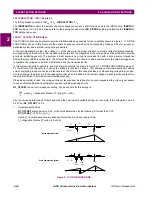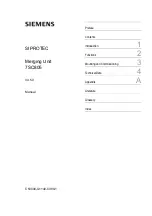
2-36
ALPS Advanced Line Protection System
GE Power Management
2.3 PROTECTION SETTINGS
2 CALCULATION OF SETTINGS
2
1.
Current reversals that can occur as a result of sequential clearing of faults on a parallel line,
2.
voltage reversals that can occur for faults near capacitors on series compensated lines, and
3.
transients that can occur for external fault clearing.
The following settings are proposed:
1.
Uncompensated Lines,
Single-pole tripping schemes: TL25DRPOUT = 30 ms
Three-pole tripping schemes: TL25DRPOUT = 50 ms
2.
Series Compensated Lines or Lines Adjacent to a Series Compensated Line: TL25DRPOUT = 125 ms
1311: TL26PICKUP - Repeat Delay Timer
•
Step Distance, Blocking, POTT1 and POTT2 Schemes: Timer TL26 is not used in these schemes, therefore it will
be ignored, and any setting that is made is irrelevant.
•
Hybrid Scheme: Timer TL26 is used to delay repeat of the channel trip signal that is received from the remote terminal
of the line. It is included to provide coordination with a scheme other than an ALPS system that may be used at the
remote terminal of the line.
The following settings are proposed. With an ALPS system at the remote terminal of the line:
TL26PICKUP = 0 ms
With other than an ALPS system at the remote terminal of the line:
TL26PICKUP =
where:
is the maximum difference in operating time between the blocking functions in the ALPS
and the tripping functions in the system at the remote end of the line. If
, ignore this
term in the calculation
C is the channel time of the communications channel.
P is the channel propagation time from the remote terminal to the local terminal.
2.3.16 LINE INFO
1401: POSSEQANG - Positive Sequence Impedance Angle
POSSEQANG is common to all of the distance functions and establishes the positive sequence angle of maximum reach.
Set POSSEQANG to a value that is equal to or just larger than the angle of the positive-sequence impedance of the pro-
tected line.
1402: ZERSEQANG - Zero Sequence Impedance Angle
ZERSEQANG is common to all of the ground distance functions and establishes the zero sequence angle of maximum
reach. Set ZERSEQANG to a value that is equal to, or just larger than, the angle of the zero-sequence impedance of the
protected line.
1403: ZLINE - Positive Sequence Line Impedance
ZLINE is used in determining fault location. Set ZLINE equal to the positive-sequence impedance of the protected line.
1404: ZEROSEQK0 - Zero Sequence Current Compensation
ZEROSEQK0 establishes the amount of zero-sequence current that is used in all of the ground distance functions (except
Zone 1) to provide "self-compensation." This permits the reach setting for the ground distance functions to be based on the
positive-sequence impedance of the protected line. Use the following setting:
ZEROSEQK0 =
, where
= zero-sequence impedance of line and
= positive-sequence impedance of line.
1405: LINELENGTH - Line Length
LINELENGTH is used as part the fault location algorithm and allows the ALPS system to report the location of the fault in
miles or kilometers (see Protection Setting 1406 below) relative to the relay location. Set LINELENGTH equal to the length
of the line in terms of the units used in Protection Setting 1406.
Z
Blocal
Z
Tremote
–
P
C
+
+
Z
Blocal
Z
Tremote
–
Z
Blocal
Z
Tremote
<
Z
0
L
Z
1
L
⁄
Z
0
L
Z
1
L
Содержание ALPS
Страница 2: ......
Страница 4: ......
Страница 182: ...5 20 ALPS Advanced Line Protection System GE Power Management 5 5 MOB TESTING 5 FUNCTIONAL TESTS FACTORY SETTINGS 5 ...
Страница 200: ...6 18 ALPS Advanced Line Protection System GE Power Management 6 5 ZONE REACH TESTS 6 FUNCTIONAL TESTS USER SETTINGS 6 ...
Страница 346: ...D 4 ALPS Advanced Line Protection System GE Power Management D 1 KEYPAD MENUS APPENDIXD D ...
Страница 352: ...F 2 ALPS Advanced Line Protection System GE Power Management F 1 WARRANTY INFORMATION APPENDIXF F ...
Страница 366: ...xiv ALPS Advanced Line Protection System GE Power Management INDEX INDEX ...
















































